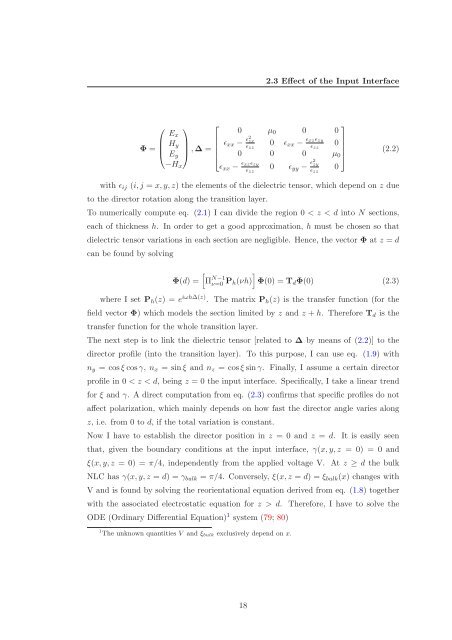Solitons in Nonlocal Media
Solitons in Nonlocal Media
Solitons in Nonlocal Media
Create successful ePaper yourself
Turn your PDF publications into a flip-book with our unique Google optimized e-Paper software.
Φ =<br />
⎛<br />
⎜<br />
⎝<br />
Ex<br />
Hy<br />
Ey<br />
−Hx<br />
⎞<br />
⎡<br />
⎟ ⎢<br />
⎟ ⎢<br />
⎠ ,∆ = ⎢<br />
⎣<br />
2.3 Effect of the Input Interface<br />
0 µ0 0 0<br />
0 ǫxx − ǫxzǫzy<br />
⎤<br />
0<br />
⎥<br />
ǫzz ⎥<br />
0 0 0 µ0⎦<br />
ǫxx − ǫ2 zx<br />
ǫzz<br />
ǫxx − ǫxzǫzy<br />
ǫzz<br />
0 ǫyy − ǫ2 zy<br />
ǫzz<br />
0<br />
(2.2)<br />
with ǫij (i, j = x, y, z) the elements of the dielectric tensor, which depend on z due<br />
to the director rotation along the transition layer.<br />
To numerically compute eq. (2.1) I can divide the region 0 < z < d <strong>in</strong>to N sections,<br />
each of thickness h. In order to get a good approximation, h must be chosen so that<br />
dielectric tensor variations <strong>in</strong> each section are negligible. Hence, the vector Φ at z = d<br />
can be found by solv<strong>in</strong>g<br />
Φ(d) =<br />
<br />
Π N−1<br />
ν=0 Ph(νh)<br />
<br />
Φ(0) = TdΦ(0) (2.3)<br />
where I set Ph(z) = e iωh∆(z) . The matrix Ph(z) is the transfer function (for the<br />
field vector Φ) which models the section limited by z and z + h. Therefore Td is the<br />
transfer function for the whole transition layer.<br />
The next step is to l<strong>in</strong>k the dielectric tensor [related to ∆ by means of (2.2)] to the<br />
director profile (<strong>in</strong>to the transition layer). To this purpose, I can use eq. (1.9) with<br />
ny = cos ξ cos γ, nx = s<strong>in</strong>ξ and nz = cos ξ s<strong>in</strong>γ. F<strong>in</strong>ally, I assume a certa<strong>in</strong> director<br />
profile <strong>in</strong> 0 < z < d, be<strong>in</strong>g z = 0 the <strong>in</strong>put <strong>in</strong>terface. Specifically, I take a l<strong>in</strong>ear trend<br />
for ξ and γ. A direct computation from eq. (2.3) confirms that specific profiles do not<br />
affect polarization, which ma<strong>in</strong>ly depends on how fast the director angle varies along<br />
z, i.e. from 0 to d, if the total variation is constant.<br />
Now I have to establish the director position <strong>in</strong> z = 0 and z = d. It is easily seen<br />
that, given the boundary conditions at the <strong>in</strong>put <strong>in</strong>terface, γ(x, y, z = 0) = 0 and<br />
ξ(x, y, z = 0) = π/4, <strong>in</strong>dependently from the applied voltage V. At z ≥ d the bulk<br />
NLC has γ(x, y, z = d) = γbulk = π/4. Conversely, ξ(x, z = d) = ξbulk(x) changes with<br />
V and is found by solv<strong>in</strong>g the reorientational equation derived from eq. (1.8) together<br />
with the associated electrostatic equation for z > d. Therefore, I have to solve the<br />
ODE (Ord<strong>in</strong>ary Differential Equation) 1 system (79; 80)<br />
1 The unknown quantities V and ξbulk exclusively depend on x.<br />
18
















